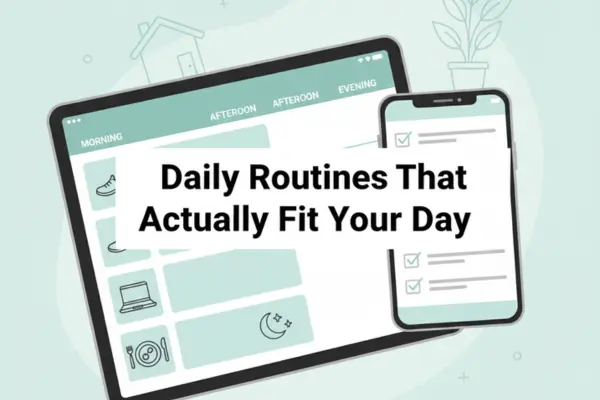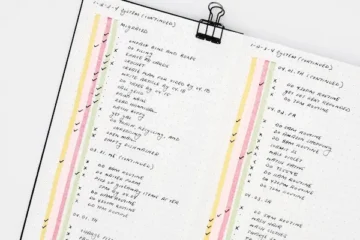Daily Routines That Actually Fit Your Day
Learn how to set daily routines that are simple, practical, and flexible. Discover how to build habits that bring balance and productivity.
Having a daily routine doesn’t mean locking yourself into a rigid schedule.
In fact, when designed properly, routines give you clarity, reduce stress, and help you make better use of your time.
The problem is that many people try to follow routines that don’t match their reality.
And when they can’t keep up, they give up, believing they “lack discipline.”
But the truth is that anyone can learn how to set daily routines that truly work.
The key is to adapt activities to your lifestyle, build habits gradually, and use simple techniques that make consistency easier.
In this guide, you’ll learn how to create a balanced daily plan that fits your schedule without overwhelming you — and that delivers real results.

Understanding how to set daily routines
First, it’s important to expand on what a daily routine really is.
It’s not about forcing yourself into a rigid schedule packed with endless tasks.
Instead, a routine is made up of simple, repeatable habits that naturally shape your day and give it structure.
When you learn how to set daily routines, you understand that the goal is not perfection but balance.
A routine should adapt to your lifestyle, support your priorities, and make space for both responsibilities and rest.
This approach makes your life lighter, more organized, and much easier to manage.
- Routines bring order to chaos – they replace uncertainty with a predictable rhythm that helps you stay calm even on busy days.
- They save mental energy – you don’t waste time constantly deciding what to do next, because the flow is already mapped out.
- A good routine creates discipline naturally – repeating actions every day turns them into habits that no longer require willpower.
- Flexibility is the secret to long-term success – routines should bend when needed, giving you freedom to adjust without guilt.
- Consistency builds momentum – the more you follow your routine, the easier it becomes to stay on track.
By seeing routines as allies rather than restrictions, you gain control of your time and create a daily life that supports your goals instead of working against them.
Benefits of how to set daily routines
When you build routines that truly match your lifestyle, the results show up faster than you expect.
Instead of feeling weighed down, you begin to notice that your days run more smoothly, your energy is better distributed, and your mind feels lighter.
This happens because a well-designed routine doesn’t just organize tasks — it gives you direction, balance, and a sense of control over your life.
Here are the main benefits of learning how to set daily routines explained in more detail:
- More productivity – By structuring your day, you reduce wasted time and use each moment more efficiently. Even small gaps in your schedule can be filled with meaningful actions.
- Less stress – Having clarity about what to do and when to do it reduces mental overload. You no longer need to improvise all the time or worry about forgetting something important.
- Better health – A balanced routine naturally includes breaks, meals at regular times, and space for exercise or rest, which keeps your body and mind in harmony.
- Natural discipline – Over time, repeated actions turn into habits. That means you don’t need to force yourself; discipline becomes automatic.
- Constant motivation – Each completed task gives you a sense of achievement. These small daily victories add up, keeping you motivated and confident to move forward.
- Improved decision-making – With routines in place, you avoid decision fatigue. Instead of asking yourself what to do next, your schedule already provides the answer.
- Greater balance – By designing a routine that covers work, family, and personal care, you create space for all areas of life without sacrificing one for the other.
- In short, a well-structured routine doesn’t trap you — it frees you.
It helps you live with more purpose, reduces wasted energy, and ensures that each day moves you closer to the life you want.
Common mistakes in how to set daily routines
Even though creating a daily routine sounds simple, many people give up along the way because they unknowingly repeat the same mistakes.
Instead of helping, their routines end up creating more stress, and little by little they abandon the practice altogether.
Understanding what not to do is just as important as learning how to set daily routines the right way.
Here are some of the most common pitfalls explained in more depth:
- Copying someone else’s routine – It’s tempting to follow a famous influencer’s “perfect schedule” or copy a coworker’s plan, but your lifestyle, responsibilities, and energy levels are unique. A routine only works when it’s customized to you.
- Overloading your schedule – Many people get excited and pack their routine with dozens of tasks. The result? Frustration and burnout. A functional routine should be realistic, leaving space for both responsibilities and rest.
- Ignoring your natural rhythm – Some people are more productive in the morning, while others focus better at night. Going against your biological clock makes routines harder to maintain. Aligning tasks with your peak energy hours is key.
- Lack of flexibility – Life is unpredictable. If your routine is too rigid, a single unexpected event can throw the whole plan off. Building flexibility into your schedule ensures you can adjust without feeling like you failed.
- Not reviewing your routine – What works today may not work six months from now. Jobs change, family dynamics shift, and personal goals evolve. Reviewing and updating your routine keeps it relevant and effective.
- Chasing perfection instead of consistency – Missing a task or skipping a day doesn’t mean your routine is broken. The goal is steady progress, not flawless execution.
By avoiding these mistakes, you create routines that are practical, sustainable, and truly aligned with your reality.
And the best part? Once your routine becomes natural, you’ll feel less pressure and more balance, turning your days into something lighter and more rewarding.
How to set daily routines step by step
Now let’s look at a practical guide to building a light, functional daily routine.
Start with essentials
List your main priorities such as work, studies, health, and family.
Create time blocks
Group activities into periods like morning, afternoon, and evening.
Add small habits
Include quick actions like drinking water or stretching to build motivation.
Use visual reminders
A planner, app, or even sticky notes can help you stay on track.
Review weekly
Adjust your routine whenever you find gaps or changes in your daily life.
Tools for how to set daily routines
Technology can be a big ally when building consistency.
| Tool | Main function | Best for |
|---|---|---|
| Google Calendar | Scheduling with reminders | People who want simple organization |
| Trello | Visual boards and lists | Teams or personal projects |
| Notion | Fully customizable routines | People who like personalization |
| Habitica | Gamified routine tracking | People who need extra motivation |
| Physical planner | Manual organization | People who prefer pen and paper |
How to set daily routines for work
At work, having a structured routine is one of the most effective ways to boost productivity and reduce unnecessary stress.
Instead of spending energy deciding what to do next, your schedule guides you, helping you stay focused and efficient.
When you learn how to set daily routines in the workplace, you not only organize your time better but also create healthier boundaries that prevent burnout.
Here are some key strategies to build a work routine that fits your day:
- Set time blocks for important tasks – Dedicate focused periods to deep work without interruptions. Silence notifications and let your team know you’ll be unavailable for that time. This ensures you complete the most valuable tasks without distractions.
- Use strategic breaks to recharge – Productivity doesn’t come from working nonstop. Short breaks every couple of hours help you reset your energy and maintain focus throughout the day. A quick stretch, a glass of water, or a short walk can make a big difference.
- Schedule meetings instead of leaving them to chance – Meetings without planning often disrupt your flow. By setting clear times for calls and discussions, you protect your calendar and keep space for focused work.
- Reserve time to review progress daily – End each day by reflecting on what you accomplished and preparing for the next. This habit gives you closure and makes tomorrow easier to start with clarity.
- Balance collaborative and individual work – Structure your routine so team-related tasks don’t overwhelm your solo priorities. Striking this balance ensures you stay productive without neglecting teamwork.
- Keep boundaries clear – A healthy work routine includes knowing when to stop. Setting limits on your workday prevents exhaustion and creates time for your personal life.
By following these steps, you transform your routine from a simple schedule into a tool that brings more order, efficiency, and peace of mind to your workday.
How to set daily routines in personal life
At home, balanced routines are key to well-being.
- Include self-care activities.
- Set regular meal times.
- Reserve time for family and leisure.
- Create a nighttime routine to relax and improve sleep.
How to set daily routines with flexibility
Many people believe routines mean rigidity.
But in practice, flexibility is what makes them sustainable.
- Leave empty spaces for unexpected events.
- Adjust tasks according to your daily energy.
- Remember that missing a day doesn’t mean failure.
How to set daily routines and stay motivated
Staying motivated is the biggest challenge.
That’s why you need to create small rewards that make consistency easier.
- Reward yourself for completing steps.
- Use checklists to visualize your progress.
- Stay inspired by your past results.
- Celebrate every small achievement.
Best practices for how to set daily routines
For your routine to truly work long-term, follow these best practices:
- Start small and add more gradually.
- Always include rest and leisure.
- Review and adapt regularly.
- Balance responsibilities with enjoyment.
- Be patient — habits take time to solidify.
Compliance and transparency
This article is for educational purposes and aims to share best practices on how to set daily routines in a practical and accessible way.
We have no partnership, affiliation, or control over the platforms, tools, or brands mentioned.
The information shared is general and should be adapted to your personal reality.
Our mission is to provide reliable, safe content aligned with Google’s compliance and best practice guidelines.




